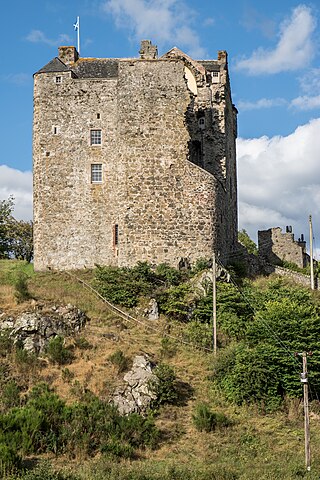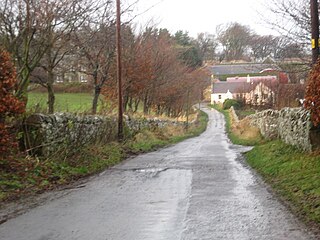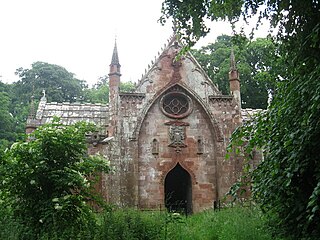
Marquess of Tweeddale is a title of the Peerage of Scotland, created in 1694 for the 2nd Earl of Tweeddale. Lord Tweeddale holds the subsidiary titles of Earl of Tweeddale, Earl of Gifford (1694), Viscount of Walden (1694), Lord Hay of Yester (1488), and Baron Tweeddale, of Yester in the County of Haddington (1881), all but the last in the Peerage of Scotland. As Baron Tweeddale in the Peerage of the United Kingdom, Lord Tweeddale sat between 1881 and 1963 in the House of Lords. The Marquess's eldest son uses Viscount Walden as a courtesy title.

Earl of Dalhousie, in the County of Midlothian, is a title in the Peerage of Scotland, held by the Chief of Clan Ramsay.

Neidpath Castle is an L-plan rubble-built tower house, overlooking the River Tweed about 1 mile (1.6 km) west of Peebles in the Borders of Scotland. The castle is both a wedding venue and filming location and can be viewed by appointment.
Sir Robert Lauder of the Bass was a Scottish knight, armiger, and Governor of the Castle at Berwick-upon-Tweed. He was also a member of the old Scottish Parliament. The Lauders held the feudal barony of The Bass, East Lothian, Edrington Castle and lands in the parish of Mordington, Berwickshire, Tyninghame in Haddingtonshire, and numerous other estates and properties elsewhere in Scotland.

Bara, anciently spelt Baro, is an agricultural parish in East Lothian, Scotland, which adjoins the parish of Garvald to the east, and Lauder across the Lammermuir Hills. It is south-west of Haddington.

Gifford is a village in the parish of Yester in East Lothian, Scotland. It lies approximately 4 miles (6.4 km) south of Haddington and 25 miles (40 km) east of Edinburgh.

Clan Broun, also known as Clan Brown, is a Scottish clan.
Holders of the office of Lord Chamberlain of Scotland are known from about 1124. It was ranked by King Malcolm as the third great Officer of State, called Camerarius Domini Regis, and had a salary of £200 per annum allotted to him. He anciently collected the revenues of the Crown, at least before Scotland had a Treasurer, of which office there is no vestige until the restoration of King James I when he disbursed the money necessary for the maintenance of the King's Household.

Stenton is a parish and village in East Lothian, Scotland. It is bounded on the north by parts of the parishes of Prestonkirk and Dunbar, on the east by Spott and on the west by Whittingehame. The name is said to be of Saxon derivation. The village has a number of houses, a school, and a church.

Morham, East Lothian, sometimes spelt Moram, Morum, or Morhame in old records, is the smallest (agricultural) parish in Scotland, sandwiched between five other parishes: Haddington, Garvald, Yester, Whittingehame, and Prestonkirk, in the undulating lower reaches of the Lammermuir Hills.
The Broun Baronets are a branch of the ancient Broun of Colstoun family whose estate near Haddington, East Lothian, remains to this day in the possession of a cadet family.
The first Hugh de Giffard was an influential feudal baron in Scotland, and one of the hostages for the release of King William the Lion in 1174.

Sir Robert de Lawedre (Lauder), Knt., of Quarrelwood, Edrington, and the Bass was Justiciar of Scotia, a Scottish soldier of great prominence and Captain of Urquhart Castle. He is recorded by Fordun, in his Scotichronicon, and in Extracta ex variis Cronicis Scocie as "Robertus de Lavedir 'the good'"

Giffordland is in North Ayrshire, Parish of Dalry (Cunninghame) in the former Region of Strathclyde, Scotland.

Yester Chapel is situated on the estate of Yester House, at the south-east edge of the village of Gifford in East Lothian, Scotland. The chapel is situated at grid reference NT544671. It is a Category A listed building.

Yester House is an early 18th-century mansion near Gifford in East Lothian, Scotland. It was the home of the Hay family, later Marquesses of Tweeddale, from the 15th century until the late 1960s. Construction of the present house began in 1699, and continued well into the 18th century in a series of building phases. It is now protected as a category A listed building, and the grounds of the house are included in the Inventory of Gardens and Designed Landscapes in Scotland, the national listing of significant gardens.

William Montagu Hay, 10th Marquess of Tweeddale, KT, DL, known before 1878 as Lord William Hay or Lord William Montagu Hay, was a Scottish landowner, peer and politician. He was born at Yester House, near Gifford, East Lothian, and served in British India as a member of the Bengal Civil Service and later as a Liberal Member of Parliament.
Alexander Livingston, 1st Earl of Linlithgow PC was a Scottish nobleman, courtier, and politician. His wife was Helenor Hay, Countess of Linlithgow who was a Royal tutor.
The Sheriff of the Lothians and Peebles was historically the office responsible for enforcing law and order and bringing criminals to justice in The Lothians and Peebles, Scotland. Prior to 1748 most sheriffdoms were held on a hereditary basis. From that date, following the Jacobite uprising of 1745, the hereditary sheriffs were replaced by salaried sheriff-deputes, qualified advocates who were members of the Scottish Bar.

James Hay, 7th Lord Hay of Yester (1564-1609) was a Scottish landowner and courtier.

















